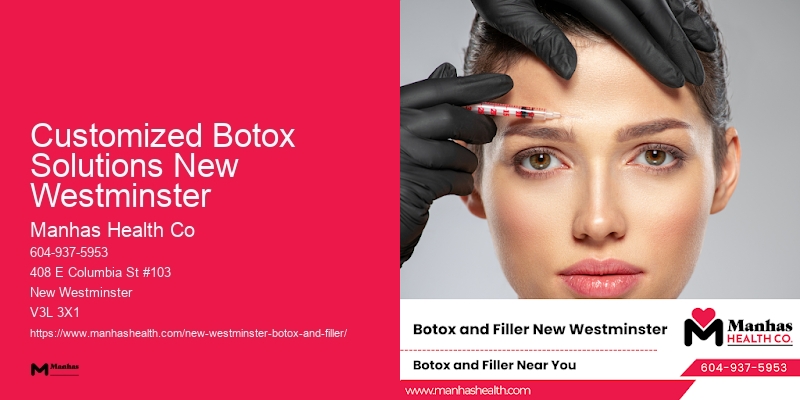

Our team of experts isn't only highly trained in the latest Botox techniques but also deeply committed to your safety and satisfaction.
By temporarily paralyzing the muscles beneath the skin, Botox doesn't just smooth out the lines we've already acquired; it also stops us from making the repetitive facial movements that lead to the development of future wrinkles. With a professional touch that's neither overzealous nor underwhelming, we've embraced this innovative treatment, recognizing its potential to not only smooth out wrinkles but to also enhance one's self-confidence. Moreover, we're here to guide you through the entire process, explaining every step and answering any questions you might have. It's important to follow post-treatment care instructions we provide, which can help reduce any discomfort and enhance the treatment's effectiveness. We understand that choosing the right provider is crucial, and we're here to ensure you receive the best possible experience and results.
| Entity Name | Description | Source |
|---|---|---|
| Botulinum toxin | Description for Botulinum toxin | Source |
| Skeletal muscle | Description for Skeletal muscle | Source |
| Eyelid | Description for Eyelid | Source |
| Eye drop | Description for Eye drop | Source |
| Injectable filler | Description for Injectable filler | Source |
| Marionette lines | Description for Marionette lines | Source |
| Lip | Description for Lip | Source |
| Dermatology | Description for Dermatology | Source |
| Mohs surgery | Description for Mohs surgery | Source |
| Skin cancer | Description for Skin cancer | Source |
| Varicose veins | Description for Varicose veins | Source |
| Melanocytic nevus | Description for Melanocytic nevus | Source |
| Collagen induction therapy | Description for Collagen induction therapy | Source |
| Platelet-rich plasma | Description for Platelet-rich plasma | Source |
| Pattern hair loss | Description for Pattern hair loss | Source |
| Skin care | Description for Skin care | Source |
| New Westminster | Description for New Westminster | Source |
| British Columbia | Description for British Columbia | Source |
| Rhinoplasty | Description for Rhinoplasty | Source |
| Masseter muscle | Description for Masseter muscle | Source |
| Submental triangle | Description for Submental triangle | Source |
| Hair loss | Description for Hair loss | Source |
| Scalp | Description for Scalp | Source |
| Hair follicle | Description for Hair follicle | Source |
| Hyperhidrosis | Description for Hyperhidrosis | Source |
| Restylane | Description for Restylane | Source |
| Physiology | Description for Physiology | Source |
The area now known as New Westminster was originally inhabited by Kwantlen First Nation The discovery of gold in BC and the arrival of gold seekers from the south prompted fear amongst the settlers that Americans may invade to take over this land.
That's why we're committed to offering our clients the best possible outcomes with every Botox session. Instead, we listen carefully to your concerns and desires, ensuring that the plan we develop is tailored just for you. This ensures that our treatment plans aren't only effective but also safe for each individual. We're committed to providing a comfortable and safe experience for everyone who walks through our doors seeking Botox treatments.
Our team continually evaluates the latest techniques and products to ensure that your personalized plan is as effective and safe as possible.

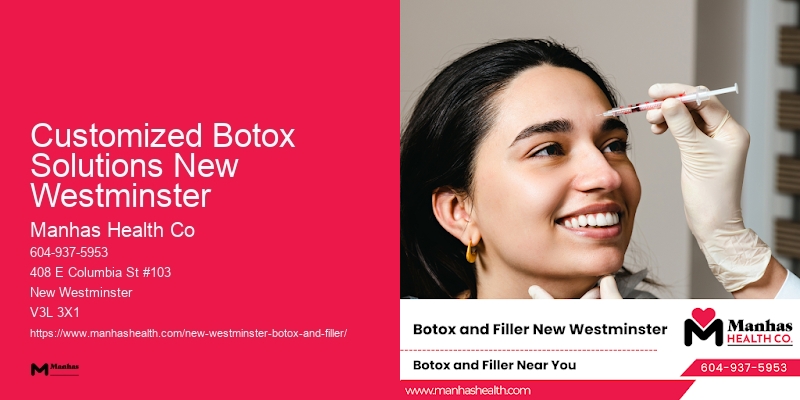
Our journey into the world of personalized Botox strategies isn't just about aesthetic enhancement-it's a testament to the art and science of skincare. Botox Providers In New Westminster It's also the perfect time to discuss your medical history and any potential impacts on your treatment plan. We're not just about providing a service; we're about creating an experience. By choosing Manhas Health Co for your Botox treatments, you're not just getting a service; you're receiving a customized care plan designed with your unique beauty in mind.
Choosing Manhas Health Co means you're not just getting a Botox treatment; you're receiving a comprehensive service that values your well-being and aesthetic aspirations. You'll start noticing the results of your Botox treatment within a few days, with the full effects typically visible after about two weeks. It's not just about aesthetics, though; understanding the science behind Botox helps us tailor treatments to each individual's needs, ensuring safety and effectiveness.
This ensures that we're always offering the most effective and safe treatments available. Now that you're familiar with what to expect from Botox treatment at Manhas Health Co, let's discuss how to secure your appointment. At Manhas Health Co. in Customized Botox Solutions New Westminster, we're excited to announce that we've added cosmetic Botox to our suite of services, making the pursuit of a youthful appearance easier and more accessible than ever.
You'll start noticing the effects of Botox within a few days, with full results visible in about two weeks. That's why we start with a thorough consultation to discuss your specific concerns and desired outcomes. That's why we offer a variety of payment options.
This is where frown lines occur, and Botox can significantly reduce these marks of concentration or concern, contributing to a friendlier, more approachable appearance. You'll need to provide some basic information such as your name, contact number, and any specific concerns or areas you'd like to focus on during your Botox treatment. At Manhas Health Co., we're experts in administering Botox in key areas to rejuvenate your appearance and boost your confidence. Our experienced practitioners are skilled in adjusting techniques and dosages to suit different facial areas, from forehead lines to crow's feet, ensuring a tailored, effective solution for each client. Botox For Neck Rejuvenation
We also stay updated with the latest industry standards and safety protocols.
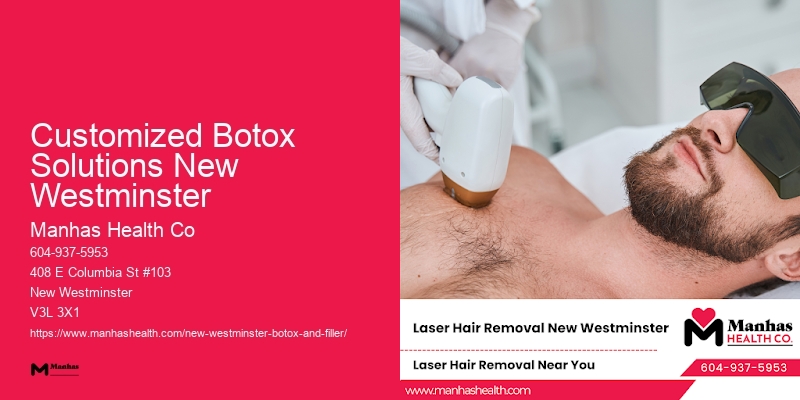
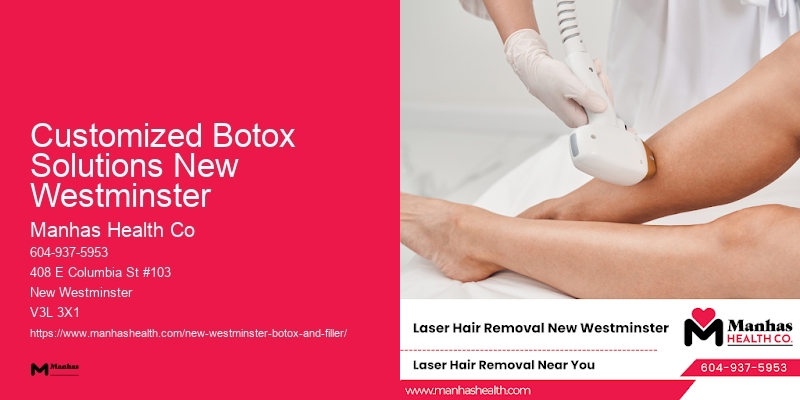
We pride ourselves on using only the highest quality Botox, guaranteeing that our clients achieve the natural-looking results they desire. We start by conducting a detailed consultation, where we listen to your desires and assess your facial anatomy. It's like I've found a piece of myself I thought was lost.'Another said, 'I was skeptical about getting Botox, worried about looking 'unnatural.' But the team at Manhas Health Co. listened to my concerns, crafted a personalized plan, and the results are astonishing.
At our clinic, we prioritize safety and precision. It's not just about looking younger; it's about feeling more confident in your skin. Let's embark on this beautiful journey together, where every step forward is a step towards feeling and looking your absolute best. We're committed to providing a seamless experience that fits into the busy lifestyles of our clients, ensuring they can enjoy the benefits of Botox without it being a burden on their time.
Having explored the transformative power of Botox, let's now consider why choosing Manhas Health Co is your best bet for this treatment.
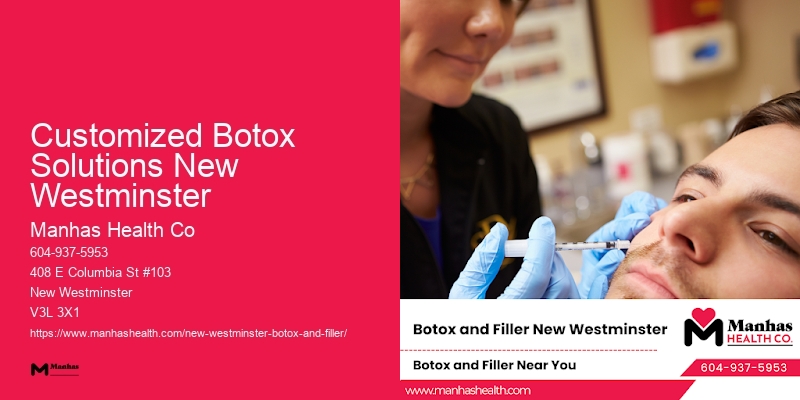

A clinic (or outpatient clinic or ambulatory care clinic) is a health facility that is primarily focused on the care of outpatients. Clinics can be privately operated or publicly managed and funded. They typically cover the primary care needs of populations in local communities, in contrast to larger hospitals which offer more specialized treatments and admit inpatients for overnight stays.
Most commonly, the English word clinic refers to a general practice, run by one or more general practitioners offering small therapeutic treatments, but it can also mean a specialist clinic. Some clinics retain the name "clinic" even while growing into institutions as large as major hospitals or becoming associated with a hospital or medical school.

The word clinic derives from Ancient Greek κλίνειν klinein meaning to slope, lean or recline. Hence κλίνη klinē is a couch or bed and κλινικός klinikos is a physician who visits his patients in their beds.[1] In Latin, this became clīnicus.[2][3]
An early use of the word clinic was "one who receives baptism on a sick bed".[4]

Clinics are often associated with a general medical practice run by one or several general practitioners. Other types of clinics are run by the type of specialist associated with that type: physical therapy clinics by physiotherapists and psychology clinics by clinical psychologists, and so on for each health profession. (This can even hold true for certain services outside the medical field: for example, legal clinics are run by lawyers.)
Some clinics are operated in-house by employers, government organizations, or hospitals, and some clinical services are outsourced to private corporations which specialize in providing health services. In China, for example, owners of such clinics do not have formal medical education. There were 659,596 village clinics in China in 2011.[5]
Health care in India, China, Russia and Africa is provided to those regions' vast rural areas by mobile health clinics or roadside dispensaries, some of which integrate traditional medicine. In India these traditional clinics provide ayurvedic medicine and unani herbal medical practice. In each of these countries, traditional medicine tends to be a hereditary practice.

The function of clinics differs from country to country. For instance, a local general practice run by a single general practitioner provides primary health care and is usually run as a for-profit business by the owner, whereas a government-run specialist clinic may provide subsidized or specialized[dubious – discuss] health care.
Some clinics serve as a place for people with injuries or illnesses to be seen by a triage nurse or other health worker. In these clinics, the injury or illness may not be serious enough to require a visit to an emergency room (ER), but the person can be transferred to one if needed.
Treatment at these clinics is often less expensive than it would be at a casualty department. Also, unlike an ER these clinics are often not open on a 24/7/365 basis. They sometimes have access to diagnostic equipment such as X-ray machines, especially if the clinic is part of a larger facility. Doctors at such clinics can often refer patients to specialists if the need arises.[6]

Large outpatient clinics vary in size, but can be as large as hospitals.
Typical large outpatient clinics house general medical practitioners (GPs) such as doctors and nurses to provide ambulatory care and some acute care services but lack the major surgical and pre- and post-operative care facilities commonly associated with hospitals.

Besides GPs, if a clinic is a polyclinic, it can house outpatient departments of some medical specialties, such as gynecology, dermatology, ophthalmology, otolaryngology, neurology, pulmonology, cardiology, and endocrinology. In some university cities, polyclinics contain outpatient departments for the entire teaching hospital in one building.

Large outpatient clinics are a common type of healthcare facility in many countries, including France, Germany (long tradition), Switzerland, and most of the countries of Central and Eastern Europe (often using a mixed Soviet-German model), as well as in former Soviet republics such as Russia and Ukraine;[7] and in many countries across Asia and Africa.[8]
In Europe, especially in the Central and Eastern Europe, bigger outpatient health centers, commonly in cities and towns, are called policlinics (derived from the word polis, not from poly-).
Recent[when?] Russian governments have attempted to replace the policlinic model introduced during Soviet times with a more western model. However, this has failed.[9]
In the Czech Republic, many policlinics were privatized or leasehold and decentralized in the post-communist era: some of them are just lessors and coordinators of a healthcare provided by private doctor's offices in the policlinic building.[10]
India has also set up huge numbers of polyclinics for former defense personnel. The network envisages 426 polyclinics in 343 districts of the country which will benefit about 33 lakh (3.3 million) ex-servicemen residing in remote and far-flung areas.[11]
Policlinics are also the backbone of Cuba's primary care system and have been credited with a role in improving that nation's health indicators.[12]


Providing health services through mobile clinics provides accessible healthcare services to these remote areas that have yet to make their way in the politicized space. For example, mobile clinics have proved helpful in dealing with new settlement patterns in Costa Rica. Before foreign aid organizations or the state government became involved in healthcare, Costa Rica's people managed their own health maintenance and protection.[13] People relied on various socio-cultural adaptations and remedies to prevent illnesses, such as personal hygiene and settlement patterns.[13] When new settlements that sprang up along the coast became "artificial" communities, and due to lack of traditional home healing practices here, alternative methods such as mobile clinics had to be implemented in these communities for the protection and prevention of diseases.[13]
A study done in rural Namibia revealed the health changes of orphans, vulnerable children and non-vulnerable children (OVC) visiting a mobile clinic where health facilities are far from the remote villages.[14] Over 6 months, information on immunization status, diagnosis of anemia, skin and intestinal disorders, nutrition, dental disorders was collected and showed that visits to mobile clinics improved the overall health of children that visited regularly. It concluded that specified "planning of these programs in areas with similarly identified barriers may help correct the health disparities among Namibian OVC and could be a first step in improving child morbidity and mortality in difficult-to-reach rural areas."[14]

Food supplementation in the context of routine mobile clinic visits also shows to have improved the nutritional status of children, and it needs further exploration as a way to reduce childhood malnutrition in resource-scarce areas. A cross-sectional study focussed on comparing acute and chronic undernutrition rates prior to and after a food-supplementation program as an adjunct to routine health care for children of migrant workers residing in rural communities in the Dominican Republic.[15] Rates of chronic undernutrition decreased from 33% to 18% after the initiation of the food-supplementation program and shows that the community members attending the mobile clinics are not just passively receiving the information but are incorporating it and helping keep their children nourished.[15]

There are many different types of clinics providing outpatient services. Such clinics may be public (government-funded) or private medical practices.
{{cite book}}: |website= ignored (help)
This article needs additional citations for verification. (March 2012) |

A facial is a family of skin care treatments for the face, including steam, exfoliation (physical and chemical), extraction, creams, lotions, facial masks, peels, and massage. They are normally performed in beauty salons, but are also a common spa treatment. They are used for general skin health as well as for specific skin conditions. Types of facials include European facial,[1] LED light therapy facials, hydrafacials and mini-facials.
There are different kinds of masks (e.g., clay, cactus, cucumber) for different purposes: deep-cleansing, by penetrating the pores; healing acne scars or hyper-pigmentation; brightening, for a gradual illumination of the skin tone. Facial masks also help with anti-aging, acne, crows feet, under eye bags, sagging lids, dark circles, puffiness,[2] and more. Some masks are designed to dry or solidify on the face, almost like plaster; others just remain wet. The green face mask is very essential and benefited.
Masks are removed by either rinsing the face with water, wiping off with a damp cloth, or peeling off of the face. Duration for wearing a mask varies with the type of mask, and manufacturer's usage instructions. The time can range from a few minutes to overnight. Those with sensitive skin are advised to first test out the mask on a small portion of the skin, in order to check for any irritations. Some facial masks are not suited to frequent use. A glycolic mask should not be used more frequently than once a month to avoid the risk of burning the skin.
Masks can be found anywhere from drugstores to department stores and can vary in consistency and form. Setting masks include: clay, which is a thicker consistency, and will draw out impurities (and sometimes, natural oils, too) from the pores; a cream, which stays damp to hydrate the skin; sheet-style, in which a paper mask is dampened with liquid to tone and moisturize the skin; and lastly, a hybrid/clay and cream form that includes small beads for removing dead surface skin cells. Non-setting facial masks include warm oil and paraffin wax masks. These different forms are made to suit different skin types (e.g., oily or dry), and different skincare goals or needs (e.g., moisturizing, cleansing, exfoliating). Clay and mud masks suit oily and some "combination" skin types,[3] while cream-based masks tend to suit dry and sensitive skin types. There are also peel-off masks which are used to remove thin layers of dead skin cells and dirt.[4]
I recently had an excellent experience with Julia, a highly professional and knowledgeable laser technician, from the moment I arrived at the reception. The staff was welcoming and efficient, setting a great tone for the visit. Julia made the entire process comfortable by thoroughly explaining the procedure and addressing all of my concerns. Her attention to detail, focus on hygiene, and personalized approach left me feeling confident in her care. Julia’s calm and friendly demeanor, combined with her expertise, resulted in fantastic treatment outcomes that exceeded my expectations. I highly recommend her and the entire team!
I recently had a great experience at Manhas. Julia has been incredibly helpful and thorough throughout the entire process. She took the time to answer all my questions and made me feel comfortable every step of the way. My first session was great with her. She walks you through every step and makes it a very comfortable experience. The atmosphere is welcoming, and the staff is professional. I highly recommend this place for anyone considering laser hair removal!
An exceptional facial experience! The skilled esthetician personalized every step to my skin's needs, leaving me glowing and refreshed. The products used were of the highest quality, and the attention to detail was remarkable. I left feeling pampered and revitalized. Definitely five stars for this facial!
The place to go for all your aesthetic needs. I've had AMAZING results with laser hair removal! Nasim and Julia have both been incredible, providing comfort, friendliness and most important the results your looking for!
I found this place on Instagram and I decided to ask for laser hair removal… I sent them a message and they booked me a session. When I arrived Ana was at the front desk, she was super lovely and happy to help( she also booked me my other 5 laser session for a very good price 😻) Dyana was my beautician, she is very sweet and careful with the technic, the session was very fast and efficient, I could see the result just right after, I was very impressed. I’m very happy with the service you provide and you deserve the good reviews so here we are! Thank you all the staff 💯⭐️
We're curious about how the cost of advanced cosmetic Botox treatments stacks up against traditional ones. It seems we might find these newer options pricier due to their cutting-edge techniques and promised results.
We've been wondering if Botox treatments can be combined with other cosmetic procedures for a full facial rejuvenation plan. It seems like a great way to achieve a more comprehensive approach to beauty enhancement.
We've wondered if cosmetic Botox treatments could affect our ability to show emotions or facial expressions. It turns out, if done correctly, it shouldn't hinder our expressions significantly but still requires careful application by professionals.